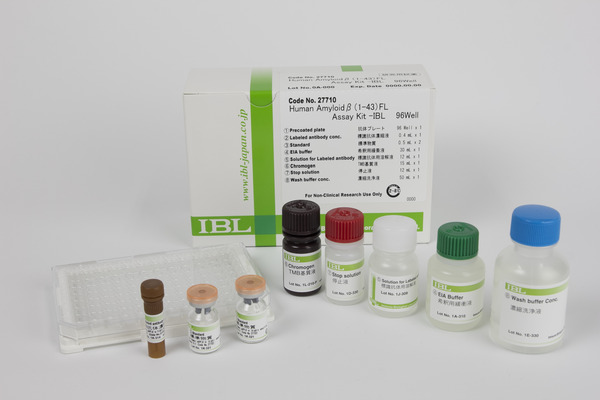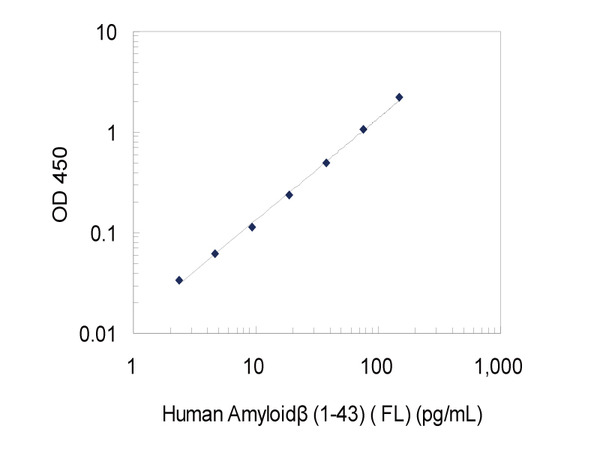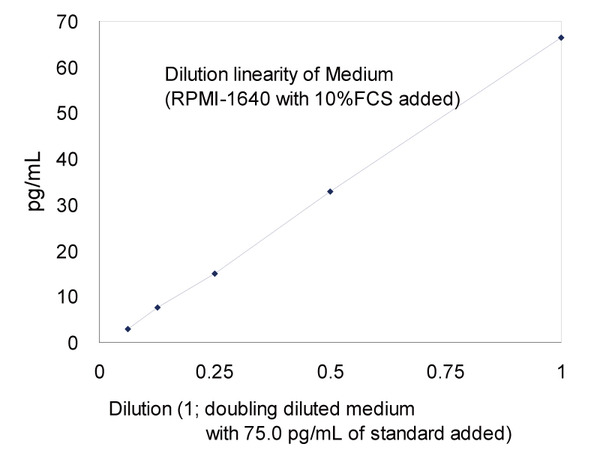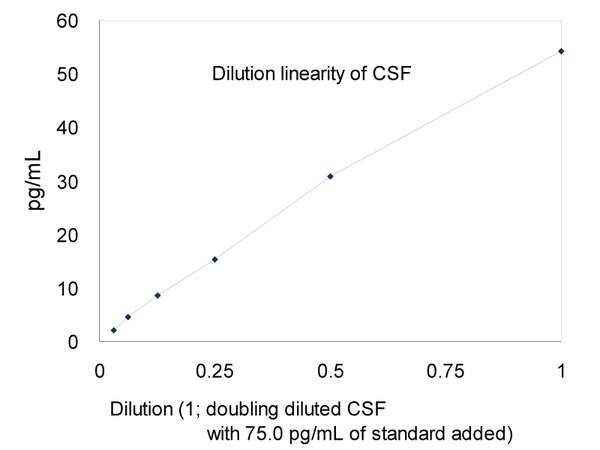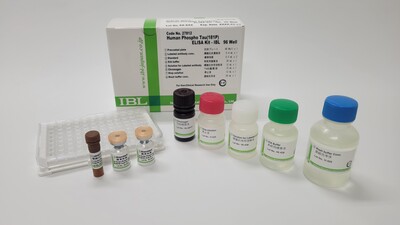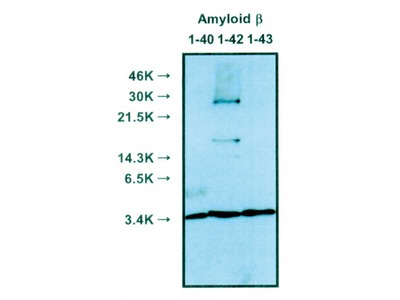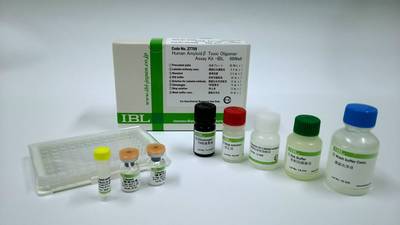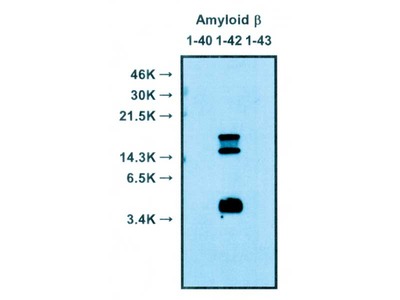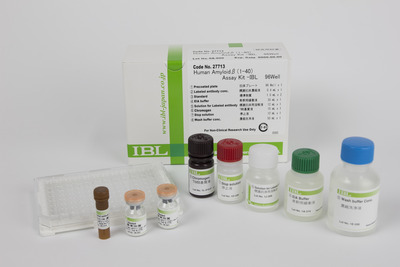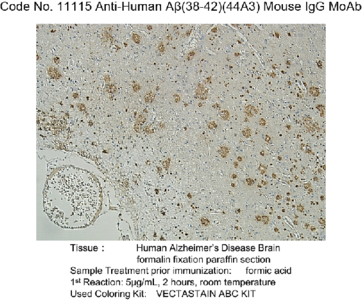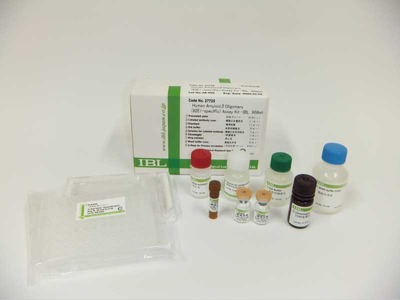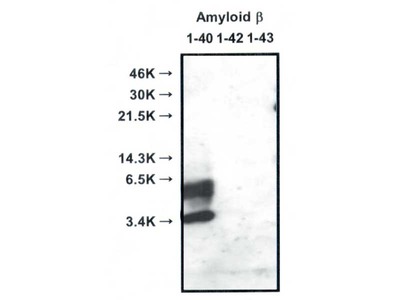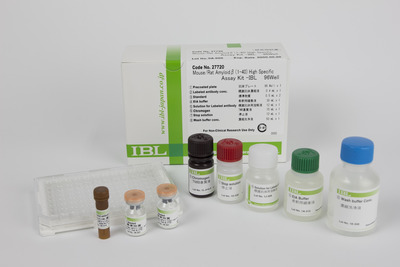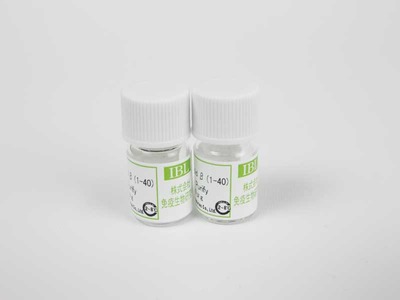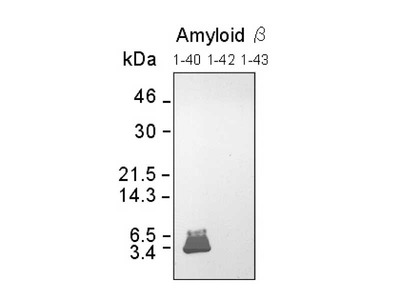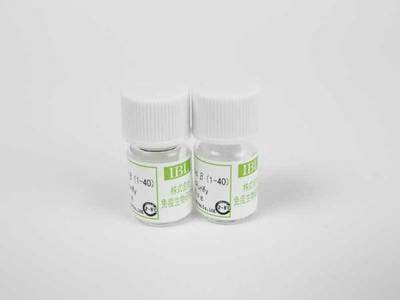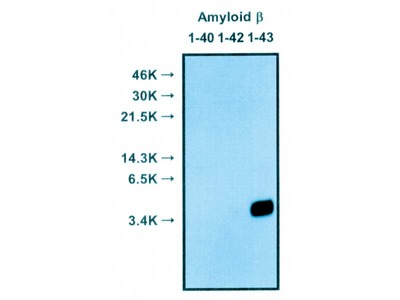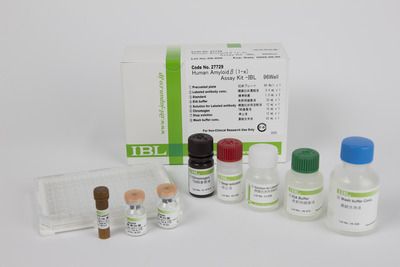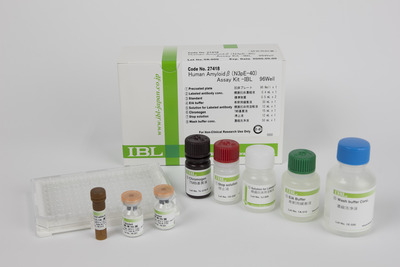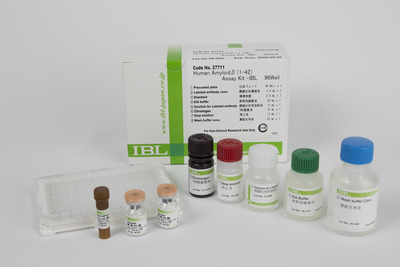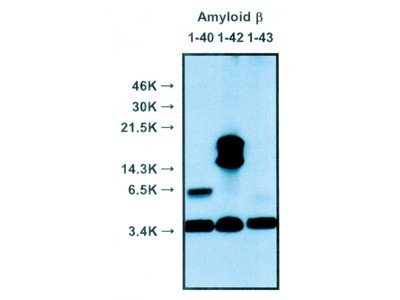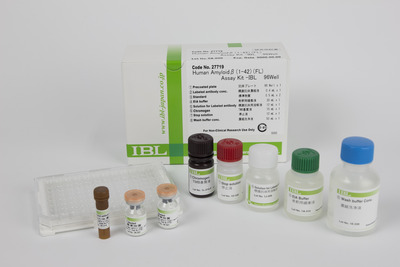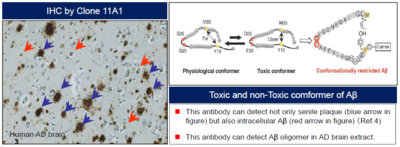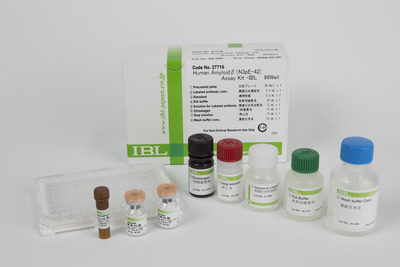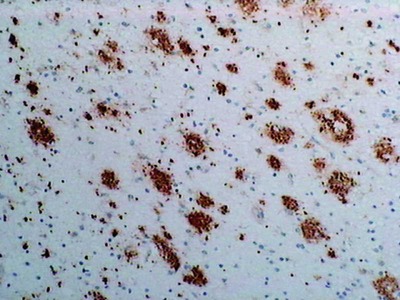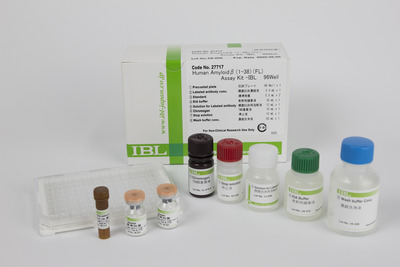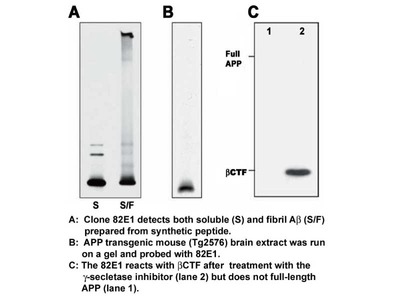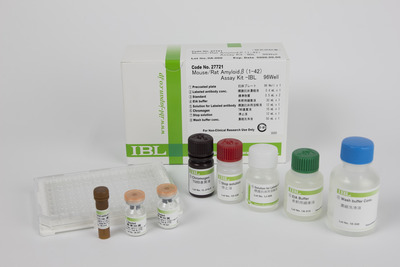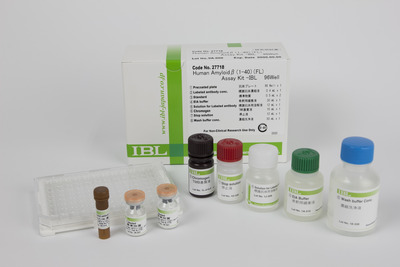- HOME >
- For Researchers >
- Product Search >
- Search Result >
- #27710 Human Amyloidβ (1-43) (FL) Assay Kit - IBL
Product Search
#27710 Human Amyloidβ (1-43) (FL) Assay Kit - IBL
- Intended Use:
- Research reagents
- Measuring Method:
- ELISA
- Sample Types:
- Human
- Measuring Samples:
- CSF, Cell culture supernatant
- Measurement Range:
- 2.34 - 150 pg/mL
- Package Size1:
- 96 Well
※ The product indicated as "Research reagents" in the column Intended Use cannot be used
for diagnostic nor any medical purpose.
※ The datasheet listed on this page is sample only. Please refer to the datasheet
enclosed in the product purchased before use.
Product Overview
Product Overview
| Product Code | 27710 |
|---|---|
| Product Name | Human Amyloidβ (1-43) (FL) Assay Kit - IBL |
| Intended Use | Research reagents |
| Measuring Method | ELISA |
| Conjugate | HRP |
| Species | Human |
| Measuring Samples | CSF, Cell culture supernatant |
| Measurement Range | 2.34 - 150 pg/mL |
| Primary Reaction | Overnight at 2 - 8 ℃ |
| Secondary Reaction | 60 minutes at 2 - 8 ℃ |
| Specificity | Compound Cross Reactivity Human Aβ (1-43) 100.0% Human Aβ (1-42) <1 % Human Aβ (1-45) <0.1 % |
| Storage Condition | 2 - 8 ℃ |
| Poisonous and Deleterious Substances | Not Applicable |
| Cartagena | Not Applicable |
| Measuring Service | Not Available |
| Package Size 1 | 96 Well |
Product Description
Product Description
The first case of Alzheimer's disease (AD) was defined and reported in 1907 by the German scientist, Dr. A. Alzheimer. His studies have shown that this is the main cause of dementia in the elderly. The plaques which appear in the brains of individuals who suffer AD are mostly constituted by the Amyloidβ protein (Aβ). Aβ is a peptide which consists of 40 or 42 (43) amino acids, and reports show that this is cleaved from β- and γ- secretase from the amyloid precursor protein. APP is a trans-membrane protein consisting of 695, 751, or 770 amino acids. Reports have shown many variants of Aβ exist and are clarified into the culture supernatant from the APP cDNA transfected mouse neuroblastoma cell. Many types of Aβ molecules are targeted in AD research. A process, Aβ40 is produced by cleaving from Aβ49 through Aβ46 and Aβ43, has been reported in tripeptide hypothesis, partly for that reason the interest in Aβ43 molecules has been growing. This kit can measure full-length (FL) molecules of Human Aβ (1-43).
Keywords:
Alzheimer's Disease / Amyloid β / Amyloid-β / Amyloid Beta / Aβ / Beta Amyloid
Keywords:
Alzheimer's Disease / Amyloid β / Amyloid-β / Amyloid Beta / Aβ / Beta Amyloid
References
References
- Carnosic acid suppresses the production of amyloid-β 1-42 and 1-43 by inducing an α-secretase TACE/ADAM17 in U373MG human astrocytoma cells. Yoshida H et al. Neurosci Res. 2014 Feb;79:83-93.PMID: 24295810
- Impact of cerebrospinal fluid shunting for idiopathic normal pressure hydrocephalus on the amyloid cascade. Moriya M et al. PLoS One. 2015 Mar 30;10(3):e0119973.PMID: 25821958
- Aβ43 is the earliest-depositing Aβ species in APP transgenic mouse brain and is converted to Aβ41 by two active domains of ACE. Zou K et al. Am J Pathol. 2013 Jun;182(6):2322-31.PMID: 23562443
- Altered γ-secretase activity in mild cognitive impairment and Alzheimer's disease. Kakuda N et al. EMBO Mol Med. 2012 Apr;4(4):344-52.PMID: 22354516
Note: Retrieve by PMID number in displayed by abstract: http://www.ncbi.nlm.nih.gov
FAQ
FAQ
-
 Q.Can this kit be used for mouse or rat samples?
Q.Can this kit be used for mouse or rat samples? -
 A.No, it cannot.
A.No, it cannot.
A monoclonal antibody (82E1) which is used as the labeled antibody in this kit, specifically reacts to N-terminal of Human Aβ.
Since the N-terminal sequence of Aβ is different between human and rodents (mouse or rat), it does not cross reacts to mouse and/or rat Aβ. -
 Q.Is composition of EIA buffer of each ELISA kit all same? Can it be mixed to use?
Q.Is composition of EIA buffer of each ELISA kit all same? Can it be mixed to use?
ELISA common FAQ -
 A.No it isn't. As constitute of each EIA buffer is different, it cannot be mixed with other lots or EIA buffers contained in other kind of ELISA kits.
A.No it isn't. As constitute of each EIA buffer is different, it cannot be mixed with other lots or EIA buffers contained in other kind of ELISA kits. -
 Q.What is the composition of concentrated wash buffer?
Q.What is the composition of concentrated wash buffer?
ELISA common FAQ -
 A.It contains ordinary Tween and phosphate buffer (0.05% Tween-20 in PB).
A.It contains ordinary Tween and phosphate buffer (0.05% Tween-20 in PB). -
 Q.What is the feature of the plate?
Q.What is the feature of the plate?
ELISA common FAQ -
 A.We use plate that is flat bottom and removable strip type plate (8wellx 12 strips).
A.We use plate that is flat bottom and removable strip type plate (8wellx 12 strips). -
 Q.Can I re-use standard after reconstitution?
Q.Can I re-use standard after reconstitution?
ELISA common FAQ -
 A.Not recommended to re-use standard after reconstitution. Please use it at once after the reconstitution.
A.Not recommended to re-use standard after reconstitution. Please use it at once after the reconstitution.
Please note that there are some exceptions. One time freeze-thaw the standard is acceptable for use after reconstitution for some ELISAs.
Please check the details on each product datasheet. -
 Q.What is different between reagent blank and test sample blank?
Q.What is different between reagent blank and test sample blank?
ELISA common FAQ -
 A.Reagent blank means a well is only added EIA buffer and the purpose is confirming whether the Test sample value is influenced by lack of washing process or other operations. Test sample blank means a well is added EIA buffer and HRP antibody and the purpose is to calculate the background.
A.Reagent blank means a well is only added EIA buffer and the purpose is confirming whether the Test sample value is influenced by lack of washing process or other operations. Test sample blank means a well is added EIA buffer and HRP antibody and the purpose is to calculate the background. -
 Q.How many samples can be measured by this kit?
Q.How many samples can be measured by this kit?
ELISA common FAQ -
 A.The pre-coated plate contained in our ELISA kit is 96 wells plate. We recommend to use 16 wells (2 slits) for standard and 80 wells (10 slits) for 40 samples in duplicate.
A.The pre-coated plate contained in our ELISA kit is 96 wells plate. We recommend to use 16 wells (2 slits) for standard and 80 wells (10 slits) for 40 samples in duplicate. -
 Q.What is LOD (Limit of Detection)?
Q.What is LOD (Limit of Detection)?
ELISA common FAQ -
 A.It (LOD) is defined as sensitivity that is calculated using the NCCSL method. Please refer to a datasheet of each product.
A.It (LOD) is defined as sensitivity that is calculated using the NCCSL method. Please refer to a datasheet of each product. -
 Q.What is LOQ (Limit of Quantification)?
Q.What is LOQ (Limit of Quantification)?
ELISA common FAQ -
 A.It (LOQ) is the lowest value of measurement (standard) range. Please refer to a datasheet of each product.
A.It (LOQ) is the lowest value of measurement (standard) range. Please refer to a datasheet of each product. -
 Q.What is the definition of Over Night (O/N) reaction?
Q.What is the definition of Over Night (O/N) reaction?
ELISA common FAQ -
 A.It means that the reaction is required more than 16 hours unless otherwise specifically defined it on a datasheet of each ELISA product.
A.It means that the reaction is required more than 16 hours unless otherwise specifically defined it on a datasheet of each ELISA product. -
 Q.What is the specification of quality control for ELISA product release?
Q.What is the specification of quality control for ELISA product release?
ELISA common FAQ -
 A.The information of specification is available on individual lot specific CoA. Please contact us with your reference lot number for obtaining of specific CoA.
A.The information of specification is available on individual lot specific CoA. Please contact us with your reference lot number for obtaining of specific CoA. -
 Q.What is the number (e.g. 432143214321) at the edge of strips of the plate?
Q.What is the number (e.g. 432143214321) at the edge of strips of the plate?
ELISA common FAQ -
 A.According to the plate maker (ThermoFisher), it does not have any specific meaning as it is just the number of molds.
A.According to the plate maker (ThermoFisher), it does not have any specific meaning as it is just the number of molds. -
 Q.How to wash an ELISA plate?
Q.How to wash an ELISA plate?
ELISA common FAQ -
 A.Washing it by an auto-washer is highly recommended.
A.Washing it by an auto-washer is highly recommended.
If it is not available, please refer to the demo video (only 2 mins) using a washing bottle. -
 Q.The wells turned black during the test with the kit.
Q.The wells turned black during the test with the kit.
ELISA common FAQ -
 A.It is possible that the wells were not washed sufficiently during the washing process after the HRP-labeled antibody reaction.
A.It is possible that the wells were not washed sufficiently during the washing process after the HRP-labeled antibody reaction.
Be sure to wash the wells enough times as described in the data sheet with washing buffer of more than 350 µL.

